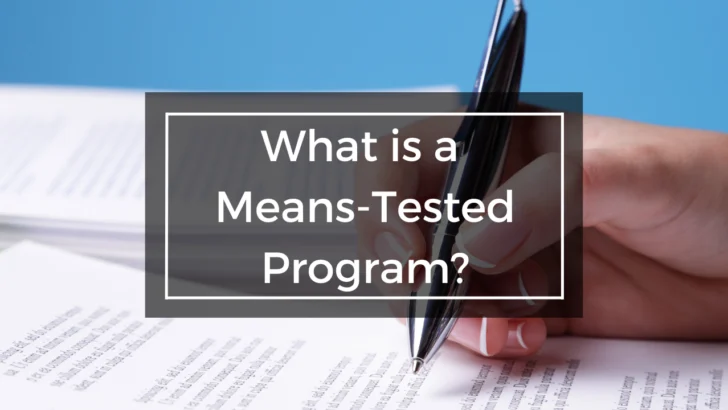What is a means-tested program?! A lot of low income programs will say that you are automatically eligible if you participate in a means-tested program but that doesn’t help you if you don’t know what they’re talking about!
When it comes to navigating the world of financial aid and assistance programs, understanding the key terminology can make a significant difference. That’s why it’s important that all low income Americans know what a means-tested program is. If you learn to speak the same language that the government and nonprofits use, it makes it so much easier to get the help that you need!
What is a means-tested program?
A means-tested program is a type of assistance program where eligibility is determined by an individual’s income or resources. A person’s financial resources are also called their “means.”
The “means test” measures whether an individual or family has enough money to live without assistance. Each means-tested program has different income and asset limits. Sometimes, the limits are very low and sometimes they are much higher. Usually, the means test is based on a percentage of the Federal Poverty Level or Area Median Income.
If the person’s income or resources fall below the program’s limits, then they qualify for the program. If their income or resources are too high, then they will not qualify for the program.
What are some means-tested programs?
Most low income assistance programs in the United States are means-tested programs. It is very, very rare to find an assistance program that does not have some sort of means test built into their eligibility requirements.
Several well-known means-tested programs in the U.S. are:
- Medicaid, which provides health coverage to some low income people, families and children, pregnant women, the elderly, and people with disabilities.
- Supplemental Nutrition Assistance Program (SNAP), which provides monthly benefits to help eligible low income individuals and families buy nutritious food.
- Temporary Assistance for Needy Families (TANF), which provides temporary financial assistance to pregnant women and families with one or more dependent children.
- Section 8 Housing Choice Voucher Program, which assists low income families, the elderly, and the disabled to afford safe and sanitary housing.
- Supplemental Security Income (SSI), which provides cash to meet basic needs for food, clothing, and shelter for aged, blind, and disabled people who have little or no income.
Millions of low income Americans participate in these programs and will recognize their names. However, relatively few people know that this is what agencies are talking about when they refer to means-tested programs.
Why do you need to know?
If you can get help from one program that checks how much money you make, you can likely get help from many other programs too. Many other programs will automatically qualify you if you show proof that you are already participating in another means-tested program.
This can make it much easier to get help from other programs. You don’t have to carry around all the paperwork to prove your income if you can show that you’re already receiving SNAP benefits, Medicaid or another means-tested program. It also makes it easier for the social workers and case managers who administer these programs, because they don’t have to handle so much paperwork.
Basically, if you are already participating in a means-tested program, it serves as proof that you fall within the income or resource thresholds required to receive assistance from other programs, too!
In some states, families receiving TANF are automatically eligible for SNAP benefits without the need for additional income verification. This helps reduce administrative costs and simplifies access to essential resources for low income families.
You may also be eligible for…
If you already participate in a means-tested program, the following programs may accept your participation as proof that you meet their income requirements.
- Head Start will often accept families who are receiving SNAP or TANF automatically.
- Low Income Home Energy Assistance Program (LIHEAP) will automatically qualify households who receive TANF or SSI in many states.
- Lifeline can provide free cell phone service to people who already receive SNAP, Medicaid or SSI.
- Museums for All will provide discounted admission to people who have an EBT card or WIC voucher.
- National School Lunch Program can provide free and reduced-price school meals to families who receive SNAP or TANF benefits.
- Weatherization Assistance Program will usually automatically qualify anyone who is receiving SSI or LIHEAP benefits.
- WIC will usually automatically cover eligible families who are receiving Medicaid, SNAP or TANF benefits.
Remember, participation usually only proves that you are qualified based on income. For example, not all families who get SNAP can get WIC, even though participating in SNAP shows that you meet the WIC income limits. That’s because WIC requires you to have a child under the age of 5 (or an eligible mother) in your household as well.
Conclusion
Understanding what means-tested programs are and how they work is crucial for low income Americans. Not only do these programs provide much-needed assistance, but participation in one can often simplify the process of receiving aid from another. By familiarizing yourself with means-tested programs, you can better navigate the resources available to you, ensuring you receive the support you need to enhance your quality of life.

